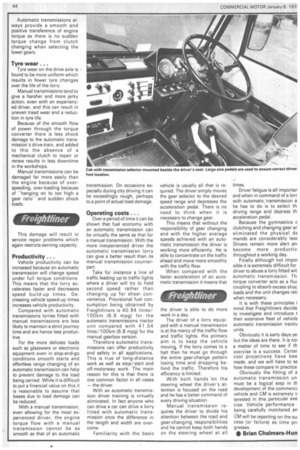FreigN/iner
Page 46

If you've noticed an error in this article please click here to report it so we can fix it.
This damage will result in service repair problems which again restricts earning capacity.
Productivity . . .
Vehicle productivity can be increased because an automatic transmission will change speed under full torque conditions. This means that the lorry accelerates faster and decreases speed build-up times. Decreasing vehicle speed-up times increases vehicle productivity.
Compared with automatic transmissions lorries fitted with manual transmissions are less likely to maintain a strict journey time and are hence less productive.
For the more delicate loads such as glassware or electronic equipment even in stop-and-go conditions smooth starts and effortless range changing of an automatic transmission can help to prevent damage to the load being carried. While it is difficult to put a financial value on this it is reasonable to assume that losses due to load damage can be reduced.
With a manual transmission, even allowing for the most experienced driver, the engine torque flow with a manual transmission cannot be as smooth as that of an automatic transmission. On occasions especially during city driving it can be exceedingly rough, perhaps to a point of actual load damage.
Operating costs...
Over a period of time it can be shown that fuel economy with an automatic transmission can be virtually the same as that for a manual transmission. With the more inexperienced driver the automatic transmission lorry can give a better result than its manual transmission counterpart.
Take for instance a line of traffic leading up to traffic lights where a driver will try to hold second speed rather than changing up for sheer convenience. Provisional fuel consumption being obtained by Freightliners is 40.94 litres/ 100km (6.9 mpg) for the automatic transmissions tractor unit compared with 41.54 litres/100km (6.8 mpg) for the manual gearbox version.
Therefore automatic transmissions can offer productivity and safety in all applications. This is true of long-distance work as well as stop/start and off-motorway work. The main reason for this is that there is one common factor in all cases — the driver.
With an automatic transmission driver training is virtually eliminated. In fact anyone who can drive a car can drive a lorry fitted with automatic transmission once the difference in the length and width are overcome.
Familiarity with the basic vehicle is usually all that is required. The driver simply moves the gear selector to the desired speed range and depresses the acceleration pedal. There is no need to think when it is necessary to change gear.
This means that without the responsibility of gear changing and with the higher average speeds achieved with an automatic transmission the driver is working more efficiently. He is able to concentrate on the traffic ahead and move more smoothly with the traffic flow.
When compared with the faster acceleration of an automatic transmission it means that the driver is able to do more work in a day.
The driver of a lorry equipped with a manual transmission is at the mercy of the traffic flow and traffic lights. His primary aim is to keep the vehicle moving,. If the lorry comes to a halt then he must go through the entire gear-change pattern losing time and dropping behind the traffic. Therefore his efficiency is limited.
With both hands on the steering wheel the driver's attention is focused on the road and he has a better command ol every driving situation.
Manual transmission requires the driver to divide his attention between the road and gear-changing responsibilities and he cannot keep both hands on the steering wheel at all times.
Driver fatigue is all importan and when in command of a lorr with automatic transmission a he has to do is to select th driving range and depress th acceleration pedal.
Because the gymnastics c clutching and changing gear ar eliminated the physical dE mends are considerably lest Drivers remain more alert an become more prod uctiv throughout a working day.
Finally although not impo sible it is extremely difficult for driver to abuse a lorry fitted wit automatic transmission. Th torque converter acts as a fluj coupling to absorb excess shoc loads and the unit changes rati when necessary.
It is with these principles i mind that Freightliners decide to investigate and introduce t their extensive fleet of vehicle automatic transmission tractiv units.
Obviously it is early days ye but the ideas are there. It is no a matter of time to see if th exercise is a success. Certai cost projections have bee made, and we will have to se how these compare in practice Obviously the fitting of a automatic transmission un must be a logical step in th development of the commerci vehicle and CM is extremely ii terested in this particular exe cise. Vehicle performance being carefully monitored an
CM will be reporting on the sal cess (or failure) as time pri gresses.




















































































